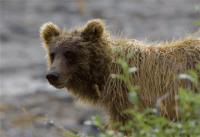
North American grizzly bear (Ursus arctos) in Denali National Park, Alaska. A fascinating new study from the May/June 2007 issue of Physiological and Biochemical Zoology quantifiably measures the loss of strength and endurance in black bears during long periods of hibernation. T.D. Lohuis (Alaska Department of Fish and Game) and his coauthors find that black bears in hibernation lose about one-half as much skeletal muscle strength as humans confined to bed rest for similar periods of time do.
"Fasting, unweighting, or immobility results in compromised muscle function," explain the authors. They continue, "Because bears are confined and anorexic for several months during winter but can still retain muscle protein and display sustained activity if disturbed, we measured skeletal muscle strength, fatigue resistance, and in vivo contractile properties of intact muscles in bears within their natural dens."
Adapting a system used for the evaluation of neuromuscular disease progression in humans, the researchers tested black bears from Middle Park, Colorado, both early and late in the hibernation cycle. After sampling, bears were placed back in their den, and the entrance was covered with pine boughs and snow.
The researchers found that after 110 days of anorexia and confinement in the den, bears lost about 29% of their muscle strength. In comparison, humans on a balanced diet but confined to bed for 90 days have been reported to lose 54% of their strength. Other studies have shown that human astronauts in a weightless environment lose 9%–11% of their strength during a 17-day spaceflight.
Black bears also sustained only a moderate loss of fatigue resistance, the researchers found: "After 110 days of fasting and limited mobility imposed by denning, bears still exhibited a fatigue profile similar to that of healthy, active, fed humans."
In contrast to other, smaller hibernating mammals such as prairie dogs and squirrels, black bears also conserved muscle protein and size. The researchers found no loss in the fiber cross-sectional area of the bears’ thighs or calves, a drop of only about 10% in the protein content of the thighs, and no reduction in protein content in the calves or quadriceps of the bears.
"Bears in this study exhibited remarkable conservation of muscle function," write the authors. "In spite of a size difference of almost three orders of magnitude and a 30 degree Celsius difference in torpor body temperature, the black bear may conserve muscle function to the extent of or perhaps better than small-mammal hibernators."
Since 1928, Physiological and Biochemical Zoology has presented current research in environmental, adaptational, and comparative physiology and biochemistry. Original research results represent a variety of areas, including thermoregulation, respiration, circulation, osmotic and ionic regulation, environmental acclimation, evolutionary physiology, and metabolic physiology and biochemistry. Source : University of Chicago Press Journals
 Print Article
Print Article Mail to a Friend
Mail to a Friend
